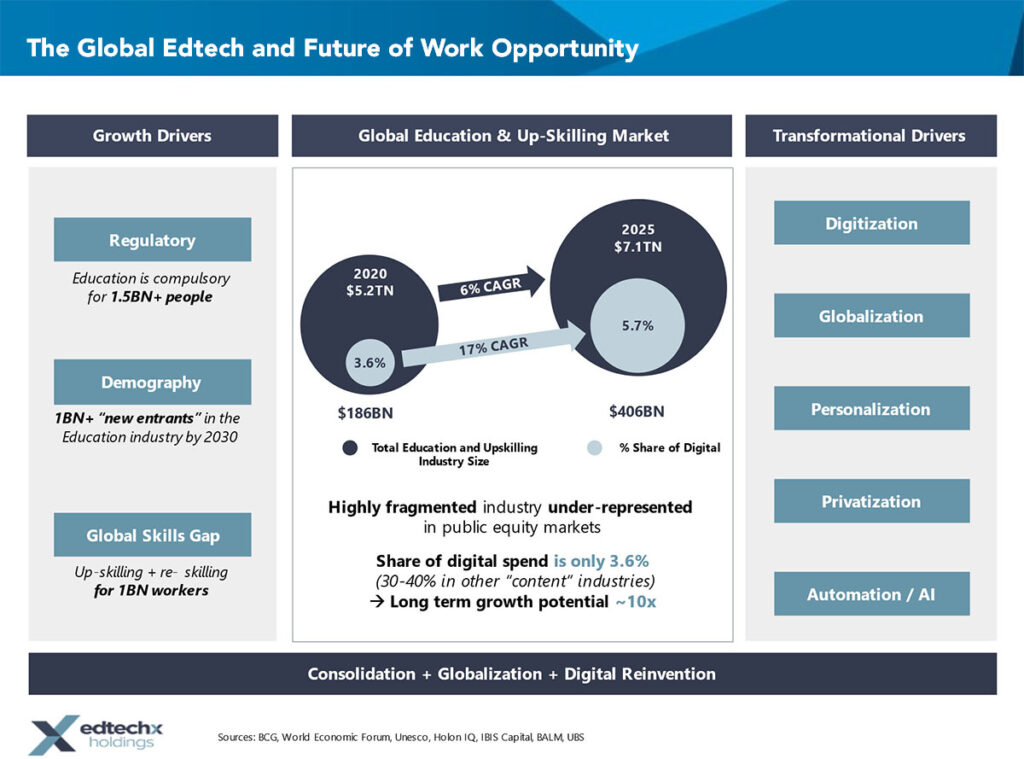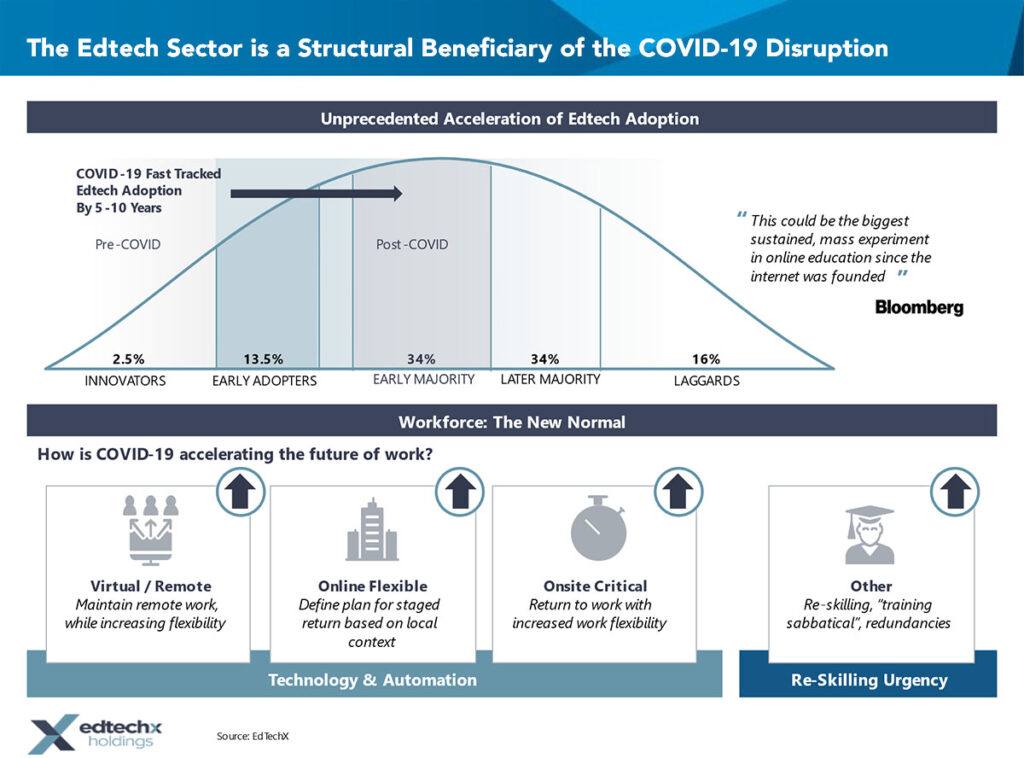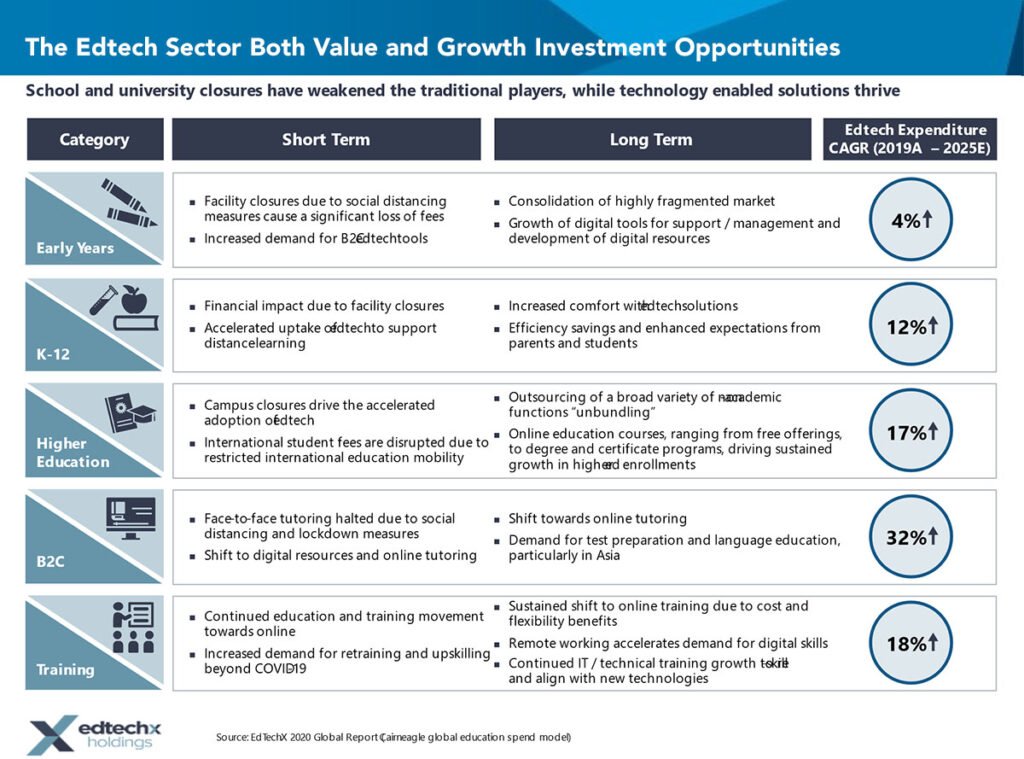Benjamin Vedrenne-Cloquet is the CEO and co-founder of EdTechX, an investment platform specialised in educational technology (edtech). He is also a chairman at the Collège Français Bilingue de Londres, and a member of the board of Educapital, a venture capital edtech fund in France.

Hello Benjamin, and nice to meet you. For those who have not yet heard of EdTechX, could you describe what kind of company it is and what you do?
EdTechX is an investment advisory and insight platform focused on the future of education and work. We have three main activities: an investment activity (through a special purpose acquisition company (SPAC) listed on the Nasdaq — which is the first one focusing on educational technology), an advisory activity, and EdTechX.
The latter is a business that gives conferences and promotes research in an attempt to provide insight on educational technologies while curating and connecting the different actors of the industry. In other words, we bring capital —and light, to that peculiar ecosystem.
Across many industries, especially more traditional sectors like education, the pandemic has accelerated digitalisation. What impact has this had, and the pandemic in general, on edtech?
The impact has been strong and good so far! To set the scene, education as an industry is very large: It represents 5.2 trillion dollars and grows at 6% per annum. This is 3X the size of the entertainment industry. What I like to call the “double billion effect” is what mainly drives growth.
On one side, demographics tell us we will have 1 billion net new entrants in the education industry by 2030. And on the other side, the global skill gap is widening due to accelerated obsolescence of skills and artificial intelligence. This creates a necessity for more than 1 billion workers to re-skill and re-train.

As we can imagine, this shock in demand won’t be absorbed by the state-funded and traditional education and training delivery systems. States can’t cope with that level of change in demand.
Historically, price increases and privatisation were the only levers to offset the unbalances between supply and demand. The third solution is tech. Tech lowers the cost of education and makes it more accessible.
As a result, even before the pandemic, the edtech market was fairly large: 180 billion dollars. However, that’s still only 3,6% of the global education market. There is at least a 10x growth opportunity.
On another note, the pandemic has had a dramatic and positive impact on the edtech market. It has fast-tracked by 5 to 10 years the adoption of technological education solutions.
At some point last year, 1.6 billion students, and as many parents, have experienced edtech solutions in some shape or form. This represents the biggest sustained mass experiment in digital education since the internet was founded.
As a result, the edtech sector is expected to grow 17% per year for the next 5 years and to reach 400 billion dollars by 2025.
At some point last year, 1.6 billion students, and as many parents, have experienced edtech solutions in some shape or form. This represents the biggest sustained mass experiment in digital education since the internet was founded.

In 2018, you commented in a few interviews on the need for capital in edtech, that capital was what was holding technology in education back, in comparison to other well-funded industries, like fintech or medtech. Where is the industry today? Is capital still an issue?
We now have much better momentum in terms of funding but still, it remains small. 50 billion dollars were invested in edtech between 2010 and 2020. Then we’ve seen a real acceleration. Venture edtech investments have doubled in 2020 ($16Bn) compared to 2018 ($8Bn).
Looking at who’s funding is also interesting: 55% of these investments come from China, 25 % from the US, 8% from India, and 4% from Europe. That’s very telling.
However, there still is an issue to fix: public companies listed in the edtech sector remain scarce.
That’s why we launched a SPAC. The combined market capitalization of all listed education and edtech companies in the world represents only 5% of the total education market. In comparison, this ratio is 50% for the healthcare sector.
What are the main trends in edtech these days?
Regarding global trends, we see much more investment and innovation in technologies oriented towards “job market readiness”. The focus is shifting on short-term micro-degrees suited to today’s job market.
There is also a lot of investment in artificial intelligence (AI), especially when it comes to personalised learning — which has proven to be more efficient than the traditional teaching method. The generational effect is also present.
Gen Y and Gen Z individuals are more interested in working for companies that have a strong corporate social responsibility (CSR) angle. They are not driven by money and career progression but by purpose, and most likely will be lifelong learners to follow their personal pursuits. This is going to transform the educational offer for sure. It also creates a need for niche education. Education providers will have to adapt!
Gen Y and Gen Z individuals are much more interested in working for companies that have a strong CSR angle. They are not driven by money and career progression but by purpose, and most likely will be lifelong learners to follow their personal pursuits. This is going to transform the educational offer for sure.

Through EdtechX, you are a pioneer of the SPACforGood initiative, could you tell us more about this? What inspired you to create this initiative?
SPACforgood is an initiative that my business partner and I pioneered when we launched our latest SPAC at the end of 2020. SPACs have collectively raised more than 80 billion dollars over the past year. There is a big inflow of capital in SPACs, not only in edtech but across all sectors.
So we felt it was right to give back, and we decided to set an example by promising 4% of the founders’ shares would go to non-profit or philanthropic initiatives supporting digital education or digital inclusion education.
We’ve made that public pledge and, thanks to this, we have attracted very progressive impact investors, and we hope other SPACs will follow.
Beyond the gift of shares, we also have decided to focus on companies that have strong ESG (Environmental, Social, and Governance) values, who are inclusive and have a positive impact on access to education.
How do you see edtech playing a role in making education more inclusive and accessible? Any best examples or case studies you can share with us?
Education is an obvious sector to invest in to promote sustainability and inclusion. And for a good reason: education is one of the main factors to a person’s success in society!
Education decreases poverty, promotes physical and mental health, closes gender gaps, minimises malnutrition, drives economic growth and so on. 80% of the cost in the delivery of education is linked to the teachers’ salaries and real estate.
If you digitize a portion of education, you lower costs massively and so improve access and inclusion. There is no way we are going to be able to build the schools and universities necessary to absorb the net entrance of 1 billion new students by 2030.
Most of that demand is coming from emerging markets (mostly Africa), so, in itself, digital learning is a huge way to make education more inclusive. Edtech is by definition an inclusive medium.
Education is a pretty good sector to invest in to promote sustainability and inclusion. And for a good reason: education is one of the main factors to a person’s success in society! Edtech is by definition an inclusive medium.
And then there are more specific initiatives driven by edtech actors. For example, online coding bootcamps for refugees in order to teach them skills, languages or tools to succeed in their new lives thanks to education.
One good example comes from a company in Africa, Bridge International Academies. They created low-cost private schools that provide a high-standard education for only $5 a month in countries where most parents earn less than $2 a day.
Are there new frontiers where edtech has yet to reach?
Looking at the future, augmented and virtual reality will become much more prevalent for corporate training and education. The concept of digital twins — introduced by ObEN, a firm specialised in AI,— is also very appealing.
Individuals would be able to create digital avatars of themselves to learn on their behalf and master new skills. I am eager to see the future interactions between AI and the human brain to unlock our ability to learn and grow. As I often say “Learning is the New Tech”.
License and Republishing
The Choice - Republishing rules
We publish under a Creative Commons license with the following characteristics Attribution/Sharealike.
- You may not make any changes to the articles published on our site, except for dates, locations (according to the news, if necessary), and your editorial policy. The content must be reproduced and represented by the licensee as published by The Choice, without any cuts, additions, insertions, reductions, alterations or any other modifications.If changes are planned in the text, they must be made in agreement with the author before publication.
- Please make sure to cite the authors of the articles, ideally at the beginning of your republication.
- It is mandatory to cite The Choice and include a link to its homepage or the URL of thearticle. Insertion of The Choice’s logo is highly recommended.
- The sale of our articles in a separate way, in their entirety or in extracts, is not allowed , but you can publish them on pages including advertisements.
- Please request permission before republishing any of the images or pictures contained in our articles. Some of them are not available for republishing without authorization and payment. Please check the terms available in the image caption. However, it is possible to remove images or pictures used by The Choice or replace them with your own.
- Systematic and/or complete republication of the articles and content available on The Choice is prohibited.
- Republishing The Choice articles on a site whose access is entirely available by payment or by subscription is prohibited.
- For websites where access to digital content is restricted by a paywall, republication of The Choice articles, in their entirety, must be on the open access portion of those sites.
- The Choice reserves the right to enter into separate written agreements for the republication of its articles, under the non-exclusive Creative Commons licenses and with the permission of the authors. Please contact The Choice if you are interested at contact@the-choice.org.
Individual cases
Extracts: It is recommended that after republishing the first few lines or a paragraph of an article, you indicate "The entire article is available on ESCP’s media, The Choice" with a link to the article.
Citations: Citations of articles written by authors from The Choice should include a link to the URL of the authors’ article.
Translations: Translations may be considered modifications under The Choice's Creative Commons license, therefore these are not permitted without the approval of the article's author.
Modifications: Modifications are not permitted under the Creative Commons license of The Choice. However, authors may be contacted for authorization, prior to any publication, where a modification is planned. Without express consent, The Choice is not bound by any changes made to its content when republished.
Authorized connections / copyright assignment forms: Their use is not necessary as long as the republishing rules of this article are respected.
Print: The Choice articles can be republished according to the rules mentioned above, without the need to include the view counter and links in a printed version.
If you choose this option, please send an image of the republished article to The Choice team so that the author can review it.
Podcasts and videos: Videos and podcasts whose copyrights belong to The Choice are also under a Creative Commons license. Therefore, the same republishing rules apply to them.





